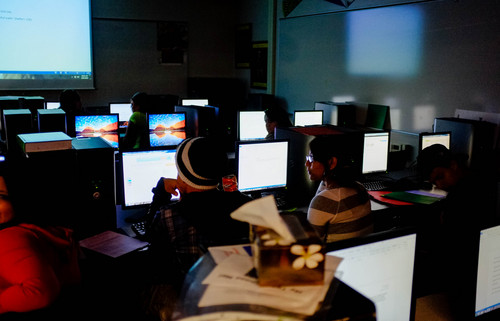This is an archived article that was published on sltrib.com in 2013, and information in the article may be outdated. It is provided only for personal research purposes and may not be reprinted.
Utah's high school dropout rate is improving, but there are still far too many students slipping through the cracks.
To grasp the breadth of the problem, picture this: 230 empty classrooms, says Dawn Stevenson, dropout prevention and career awareness coordinator for the Utah Office of Education.
"The consequence for those kids is huge," she said. "We want to help them avoid that pain."
A statewide committee of educators and academics helped the state office compile its newly published guide, "Dropout Prevention in Utah." It includes strategies teachers, counselors and principals can use to identify and help students at risk of dropping out, along with examples of successful Utah programs.
The guide will be posted soon on the Utah Office of Education website.
Utah's dropout rate was 19 percent in 2012, down from 29 percent in 2008. The 2013 rate has not yet been announced.
An estimated 8,500 students drop out each year, some as early as middle school, Stevenson said.
More than 700 high school dropouts have been surveyed through Utah State University and University of Utah, and, almost without exception, the ex-students regretted dropping out, Stevenson said.
Spotty attendance was a factor for most, and many who dropped out said their school failed to ask why. Other studies have had similar findings.
"One of the real challenges is, 'How do we reclaim those kids?'" Stevenson said.
The guide makes several recommendations, saying schools should:
• Use data to make realistic diagnoses of how many and which students are at risk.
• Assign adult advocates to at-risk students.
• Provide targeted support to boost academic performance and to improve classroom behavior and social skills.
• Personalize the learning environment.
• Provide rigorous and relevant instruction to better engage students in learning.
Among the examples of programs that help at-risk students:
• Washington School District offers a "robust" credit-recovery program, helping kids take the classes they need to graduate, through its online school, alternative high school and summer program.
• At Butler Middle School in the Canyons District, counselors identify students as early as sixth to eighth grades who, from their academic progress, attendance and engagement appear at risk of dropping out.
"Butler Middle is giving the ninth grade data for Brighton High to follow and do interventions," the guide says.
Brenda Hales, deputy superintendent of Utah schools, said the earnings gap between those who graduate and those who don't is huge.
Dropping out, she said, "is almost a guarantee, except for a few jobs, that you're going to spend your life living in poverty."
Hales said the Utah Board of Education likely will ask the Legislature for more money to address bullying, mental health and to add more school counselors, all of which could help reduce the dropout rate further.
"It's unacceptable to have anybody not graduate," Hales said.
Twitter: @KristenMoulton



